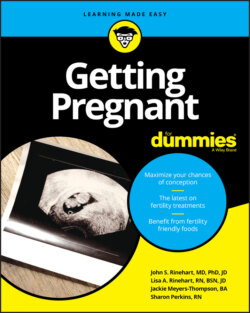Читать книгу Getting Pregnant For Dummies - Sharon Perkins - Страница 44
Taking a spin on the menstrual cycle
ОглавлениеThe hormone-secreting systems work to create your menstrual cycle like this:
1 Menstrual Phase: During menstruation, the old uterine lining breaks down and passes through the vagina as menstrual flow. This process takes three to seven days and is commonly called a “period.”
2 Follicular/Proliferative Phase: On Day 1 of bleeding, the pituitary gland, under influence from the hypothalamus, releases follicle-stimulating hormone (FSH). The rising FSH levels cause the ovaries to rescue the 10 to 20 remaining follicles, called antral follicles, which begin to grow. The cells surrounding each egg secrete a liquid, forming a follicle, a fluid-filled sac. Each follicle contains one immature egg. During the follicular phase, one follicle continues to develop, and the others die. In the ovary, the one egg-containing follicle is growing (in response to FSH and luteinizing hormone (LH), which is also produced by the pituitary), and this growing follicle begins producing estrogen. The estrogen produced by the ovary causes the uterine lining to thicken or proliferate. This is called the proliferative phase of the uterus. The follicular phase and the proliferative phase occur in the first half of the menstrual cycle. One refers to what’s happening in the ovary (follicular phase), and the other refers to what’s happening in the uterus (proliferative phase).One follicle becomes dominant, growing faster than the others. As the dominant follicle grows, it produces more estrogen, which also increases the lining of the uterus. The amount of FSH released decreases, and the smaller follicles stop growing and are reabsorbed.A large amount of LH, called an LH surge, is released from the pituitary gland as the estrogen rises. This makes the egg inside the dominant follicle mature.
3 Ovulation: The follicleopens; the egg is released (ovulation) and is picked up by one of the fallopian tubes. If the egg is joined by sperm, it will continue to travel through the fallopian tube to the uterus. The uterine lining has now developed enough to support embryo implantation, and the endometrial glands of the uterine lining secrete proteins that help guide the embryo to the correct spot.
4 Luteal phase: The leftover part of the follicle, now called the corpus luteum, produces progesterone and some estrogen, which help an embryo implant. If you are not pregnant, the corpus luteum collapses, progesterone and estrogen levels decline, the uterine lining begins to break down, and menstruation begins roughly two weeks after ovulation.
